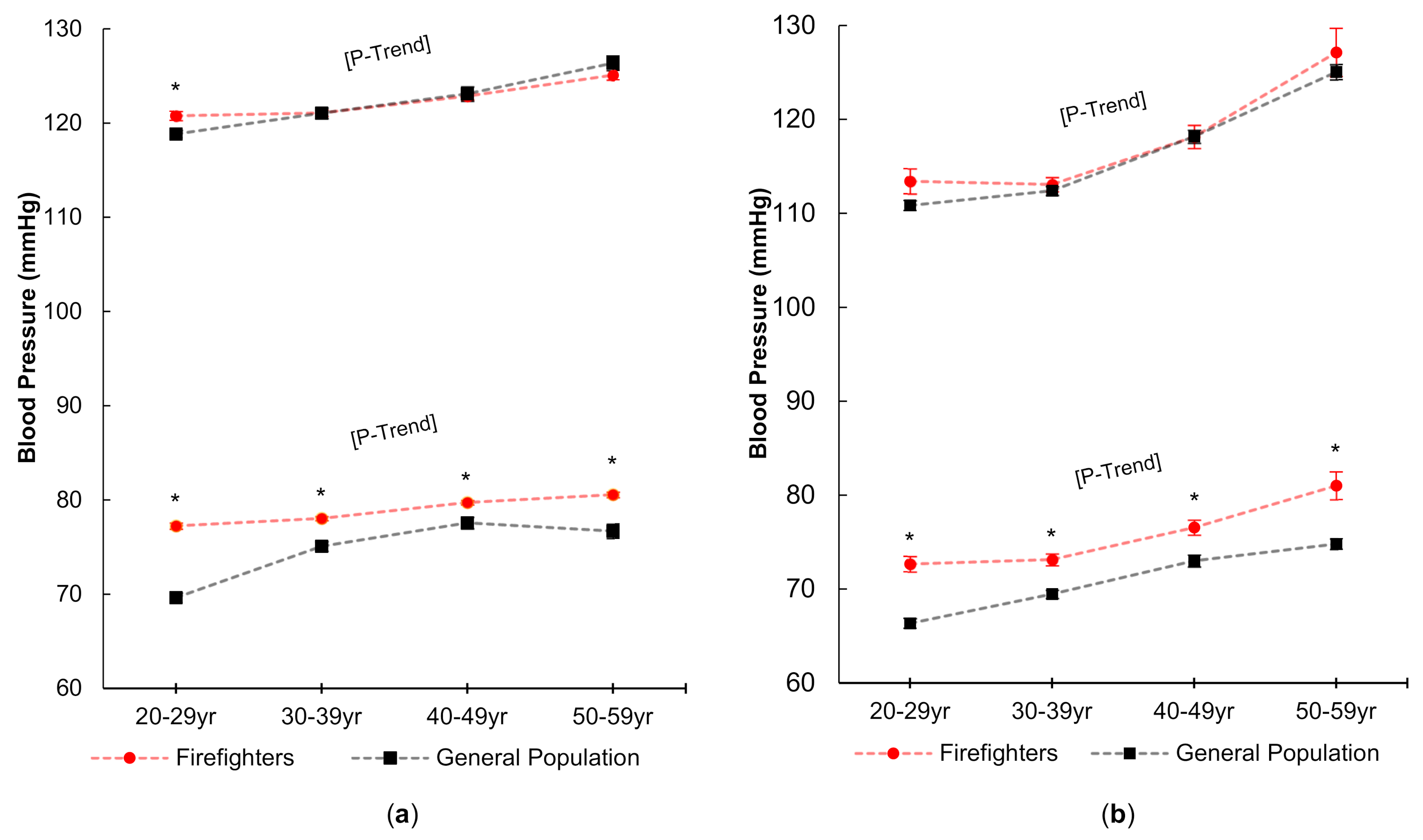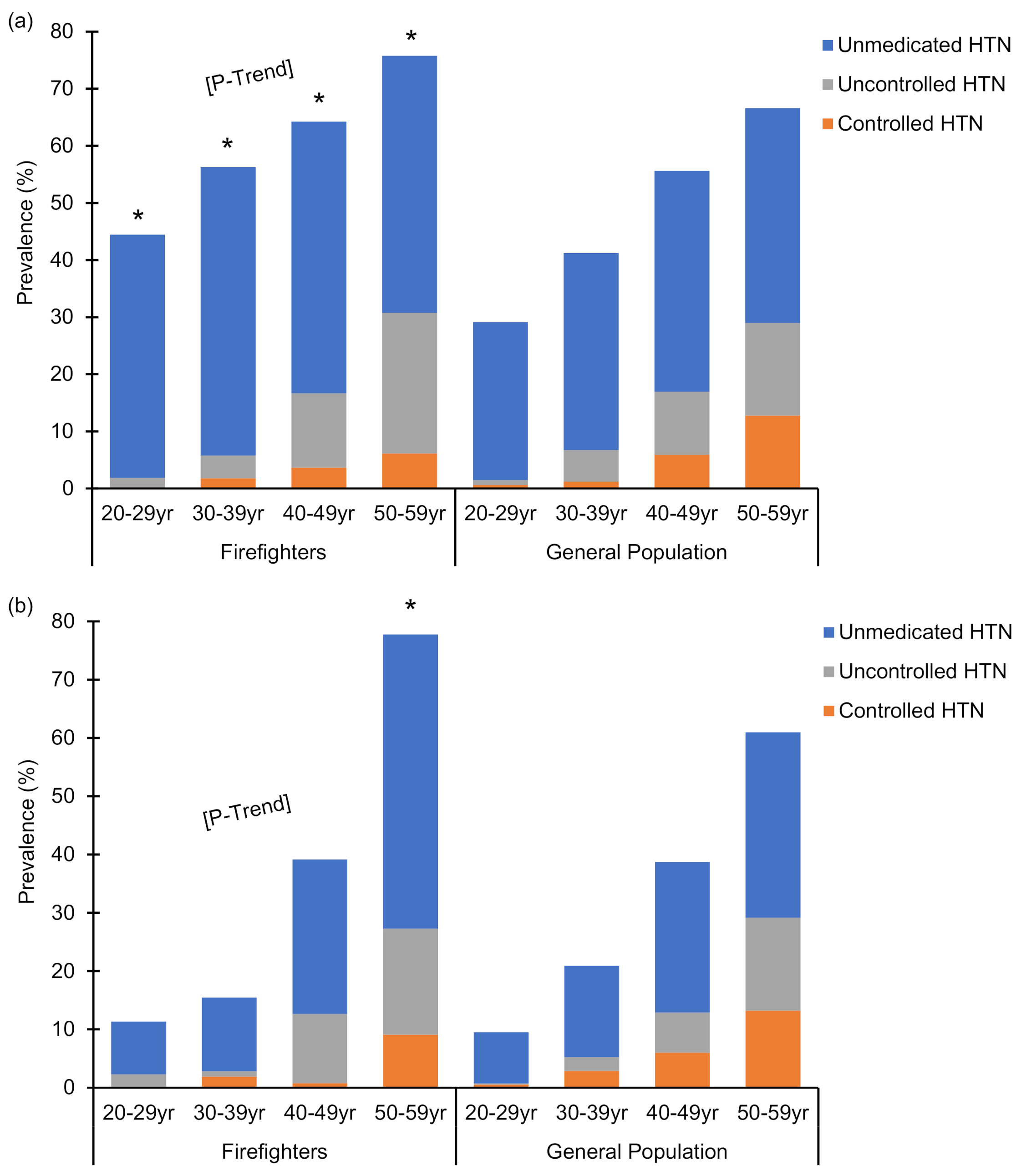Hypertension in the United States Fire Service
Abstract
1. Introduction
2. Methods
2.1. Study Sample
2.2. Measures
2.3. Statistical Analysis
3. Results
4. Discussion
Stregnths and Limitations
5. Conclusions
Supplementary Materials
Author Contributions
Funding
Institutional Review Board Statement
Informed Consent Statement
Data Availability Statement
Acknowledgments
Conflicts of Interest
References
- Tobia, M.; LeDuc, T.J.; Jahnke, S.A.; Smith, D.L. Occupational medical evaluations in the US fire service: State of the art review. Int. Fire Serv. J. Leadersh. Manag. 2020, 14, 17–26. [Google Scholar]
- Fahy, R.F.; Petrillo, J.T.; Molis, J.L. Firefighter Fatalities in the US–2019; National Fire Protection Association: Quincy, MA, USA, 2019; p. 7. [Google Scholar]
- Kales, S.N.; Soteraides, E.R.; Christophi, C.A.; Christiani, D.C. Emergency duties and deaths from heart disease among firefighters in the United States. N. Engl. J. Med. 2007, 356, 1207–1215. [Google Scholar] [CrossRef] [PubMed]
- Smith, D.L.; Haller, J.M.; Korre, M.; Sampani, K.; Grosi Porto, L.G.; Fehling, P.C.; Christophi, C.A.; Kales, S.N. The relation of emergency duties to cardiac death among US firefighters. Am. J. Cardiol. 2019, 123, 736–741. [Google Scholar] [CrossRef]
- Smith, D.L.; Haller, J.M.; Korre, M.; Fehling, P.C.; Sampani, K.; Grossi Porto, L.G.; Christophi, C.A.; Kales, S.N. Pathoanatomic findings associated with duty-related cardiac death in US firefighters: A case-control study. J. Am. Heart Assoc. 2018, 7, e009446. [Google Scholar] [CrossRef] [PubMed]
- Di Palo, K.E.; Barone, N.J. Hypertension and heart failure: Prevention, targets, and treatment. Heart Fail. Clin. 2020, 16, 99–106. [Google Scholar] [CrossRef]
- Ettehad, D.; Emdin, C.A.; Kiran, A.; Anderson, S.G.; Callender, T.; Emberson, J.; Chalmers, J.; Rodgers, A.; Rahimi, K. Blood pressure lowering for prevention of cardiovascular disease and death: A systematic review and meta-analysis. Lancet 2016, 387, 957–967. [Google Scholar] [CrossRef]
- Kales, S.N.; Soteriades, E.S.; Christoudias, S.G.; Christiani, D.C. Firefighters and on-duty deaths from coronary heart disease: A case control study. Environ. Health 2003, 2, 14. [Google Scholar] [CrossRef] [PubMed]
- Wilson, C.; Zhang, X.; Buckley, C.; Heathcote, H.R.; Lee, M.D.; McCarron, J.G. Increased vascular contractility in hypertension results from impaired endothelial calcium signaling. Hypertension 2019, 74, 1200–1214. [Google Scholar] [CrossRef] [PubMed]
- Tomiyama, H.; Ishizu, T.; Kohro, T.; Matsumoto, C.; Higashi, Y.; Takase, B.; Suzuki, T.; Ueda, S.; Yamazaki, T.; Furumoto, T.; et al. Longitudinal association among endothelial function, arterial stiffness and subclinical organ damage in hypertension. Int. J. Cardiol. 2018, 253, 161–166. [Google Scholar] [CrossRef] [PubMed]
- Noh, J.; Lee, C.J.; Hyun, D.S.; Kim, W.; Kim, M.J.; Park, K.S.; Koh, S.; Chang, S.J.; Kim, C.; Park, S. Blood pressure and the risk of major adverse cardiovascular events among firefighters. J. Hypertens. 2020, 38, 850–857. [Google Scholar] [CrossRef]
- Brook, R.D.; Rajagopalan, S. Particulate matter, air pollution and blood pressure. J. Am. Soc. Hypertens. 2009, 3, 332–350. [Google Scholar] [CrossRef] [PubMed]
- Yang, B.Y.; Qian, Z.; Howard, S.W.; Vaughn, M.G.; Fan, S.J.; Liu, K.K.; Dong, G.H. Global association between ambient air pollution and blood pressure: A systematic review and meta-analysis. Environ. Pollut. 2018, 235, 576–588. [Google Scholar] [CrossRef]
- Liu, M.Y.; Li, N.; Li, W.A.; Khan, H. Association between psychosocial stress and hypertension: A systematic review and meta-analysis. Neurol. Res. 2017, 39, 573–580. [Google Scholar] [CrossRef]
- Stokholm, Z.A.; Bonde, J.P.; Christensen, K.L.; Hansen, A.M.; Kolstad, H.A. Occupational noise exposure and the risk of hypertension. Epidemiology 2013, 24, 135–142. [Google Scholar] [CrossRef] [PubMed]
- Medic, G.; Wille, M.; Hemels, M.E. Short- and long-term health consequences of sleep disruption. Nat. Sci. Sleep 2017, 9, 151–161. [Google Scholar] [CrossRef] [PubMed]
- Davila, E.P.; Kuklina, E.V.; Valderrama, A.L.; Yoon, P.W.; Rolle, I.; Nsubuga, P. Prevalence, management, and control of hypertension among US workers: Does occupation matter? J. Occup. Environ. Med. 2012, 54, 1150–1156. [Google Scholar] [CrossRef]
- Risavi, B.L.; Staszko, J. Prevalence of risk factors for coronary artery disease in Pennsylvania (USA) firefighters. Prehosp. Disaster Med. 2016, 31, 102–107. [Google Scholar] [CrossRef]
- Kales, S.N.; Soteriades, E.S.; Christoudias, S.G.; Tucker, S.A.; Nicolaou, M.; Christiani, D.C. Firefighters’ blood pressure and employment status on hazardous materials teams in Massachusetts: A prospective study. J. Occup. Environ. Med. 2002, 44, 669–676. [Google Scholar] [CrossRef]
- Soteriades, E.S.; Kales, S.N.; Liarokapis, D.; Christiani, D.C. Prospective surveillance of hypertension in firefighters. J. Clin. Hypertens. 2003, 5, 315–320. [Google Scholar] [CrossRef]
- Choi, B.; Dobson, M.; Schnal, P.; Garcia-Rivas, J. 24-hour work shifts, sedentary work, and obesity in male firefighters. Am. J. Ind. Med. 2016, 59, 486–500. [Google Scholar] [CrossRef]
- Li, K.; Lipsey, T.; Leach, H.J.; Nelson, T.L. Cardiac health and fitness of Colorado male/female firefighters. Occup. Med. 2017, 67, 268–273. [Google Scholar] [CrossRef] [PubMed]
- Smith, D.L.; Graham, E.; Stewart, D.; Mathias, K.C. Cardiovascular disease risk factor changes over 5 years among male and female US firefighters. J. Occup. Environ. Med. 2020, 62, 398–402. [Google Scholar] [CrossRef] [PubMed]
- Davis, S.C.; Jankovitz, K.Z.; Rein, S. Physical fitness and cardiac risk factors of professional firefighters across the career span. Res. Q. Exerc. Sport 2002, 73, 363–370. [Google Scholar] [CrossRef] [PubMed]
- National Health and Nutrition Examination Survey: NHANES Questionnaires, Datasets, and Related Documentation. Available online: https://wwwn.cdc.gov/nchs/nhanes/Default.aspx (accessed on 21 July 2020).
- National Fire Protection Association (NFPA). NFPA 1582: Standard on Comprehensive Occupational Medical Program for Fire Departments; National Fire Protection Association: Quincy, MA, USA, 2020. [Google Scholar]
- Whelton, P.K.; Carey, R.M.; Aronow, W.S.; Casey, D.E., Jr.; Collins, K.J.; Dennison Himmelfarb, C.; DePalma, S.M.; Gidding, S.; Jamerson, K.A.; Jones, D.W.; et al. 2017 ACC/AHA/AAPA/ABC/ACPM/AGS/APhA/ASH/ASPC/NMA/PCNA guideline for the prevention, detection, evaluation, and management of high blood pressure in adults: A report of the American College of Cardiology/American Heart Association Task Force on Clinical Practice Guidelines. Hypertension 2018, 71, e13–e115. [Google Scholar] [PubMed]
- Defining Adult Overweight and Obesity. Available online: https://www.cdc.gov/obesity/adult/defining.html (accessed on 21 July 2020).
- National Health and Nutrition Examination Survey: Analytic Guidelines, 2011–2014 and 2015–2016. Available online: https://wwwn.cdc.gov/nchs/data/nhanes/analyticguidelines/11-16-analytic-guidelines.pdf (accessed on 21 July 2020).
- Knol, M.J.; Pestman, W.R.; Grobbee, D.E. The (mis)use of overlap of confidence intervals to assess effect modification. Eur. J. Epidemiol. 2011, 26, 253–254. [Google Scholar] [CrossRef]
- Storer, T.W.; Dolezal, B.A.; Abrazado, M.L.; Smith, D.L.; Batalin, M.A.; Tseng, C.H.; Cooper, C.B.; PHASER Study Group. Firefighter health and fitness assessment: A call to action. J. Strength Cond. Res. 2014, 28, 661–671. [Google Scholar] [CrossRef]
- Poston, W.S.; Haddock, C.K.; Jahnke, S.A.; Jitnarin, N.; Tuley, B.C.; Kales, S.N. The prevalence of overweight, obesity, and substandard fitness in a population-based firefighter cohort. J. Occup. Environ. Med. 2011, 53, 266–273. [Google Scholar] [CrossRef]
- Donovan, R.; Nelson, T.; Peel, J.; Lipsey, T.; Voyles, W.; Israel, R.G. Cardiorespiratory fitness and the metabolic syndrome in firefighters. Occup. Med. 2009, 59, 487–492. [Google Scholar] [CrossRef]
- Smith, D.L.; Fehling, P.C.; Frisch, A.; Haller, J.M.; Winke, M.; Dailey, M.W. The prevalence of cardiovascular disease risk factors and obesity in firefighters. J. Obes. 2012, 2012, 908267. [Google Scholar] [CrossRef]
- Poston, W.S.; Haddock, C.K.; Jahnke, S.A.; Jitnarin, N.; Day, R.S. An examination of the benefits of health promotion programs for the national fire service. BMC Public Health 2013, 13, 805. [Google Scholar] [CrossRef]
- Burgess, J.L.; Kurzius-Spencer, M.; Gerkin, R.D.; Fleming, J.L.; Peate, W.R.; Allison, M. Risk factors for subclinical atherosclerosis in firefighters. J. Occup. Environ. Med. 2012, 54, 328–335. [Google Scholar] [CrossRef]
- Kales, S.N.; Tsismenakis, A.J.; Zhang, C.; Soteriades, E.S. Blood pressure in firefighters, police officers, and other emergency responders. Am. J. Hypertens. 2009, 22, 11–20. [Google Scholar] [CrossRef]
- Soteriades, E.S.; Smith, D.; Tsismenakis, A.J.; Baur, D.M.; Kales, S.N. Cardiovascular disease in US firefighters: A systematic review. Cardiol. Rev. 2011, 19, 202–215. [Google Scholar] [CrossRef]
- Quinn, S.; McEvoy, J.W. Systolic and diastolic blood pressure and cardiovascular outcomes. N. Engl. J. Med. 2019, 381, 1690–1693. [Google Scholar]
- McEvoy, J.W.; Daya, N.; Rahman, F.; Hoogeveen, R.C.; Blumenthal, R.S.; Shah, A.M.; Ballantyne, C.M.; Coresh, J.; Selvin, E. Association of isolated diastolic hypertension as defined by the 2017 ACC/AHA Blood Pressure Guideline with incident cardiovascular outcomes. JAMA 2020, 323, 329–338. [Google Scholar] [CrossRef]
- Flint, A.C.; Conell, C.; Ren, X.; Banki, N.M.; Chan, S.L.; Rao, V.A.; Melles, R.B.; Bhatt, D.L. Effect of systolic and diastolic blood pressure on cardiovascular outcomes. N. Engl. J. Med. 2019, 381, 243–251. [Google Scholar] [CrossRef]
- Franklin, S.S.; Pio, J.R.; Wong, N.D.; Larson, M.G.; Leip, E.P.; Vasan, R.S.; Levy, D. Predictors of new-onset diastolic and systolic hypertension: The Framingham Heart Study. Circulation 2005, 111, 1121–1127. [Google Scholar] [CrossRef]
- Shenasa, M.; Shenasa, H. Hypertension, left ventricular hypertrophy, and sudden cardiac death. Int. J. Cardiol. 2017, 237, 60–63. [Google Scholar] [CrossRef]
- Tavora, F.; Zhang, Y.; Zhang, M.; Li, L.; Ripple, M.; Fowler, D.; Burke, A. Cardiomegaly is a common arrhythmogenic substrate in adult sudden cardiac deaths, and is associated with obesity. Pathology 2012, 44, 187–191. [Google Scholar] [CrossRef]
- Yang, J.; Teehan, D.; Farioli, A.; Baur, D.; Smith, D.; Kales, S. Sudden cardiac death among firefighters ≤45 years of age in the United States. Am. J. Cardiol. 2013, 112, 1962–1967. [Google Scholar] [CrossRef]
- Geibe, J.R.; Holder, J.; Peeples, L.; Kinney, A.M.; Burress, J.W.; Kales, S.N. Predictors of on-duty coronary events in male firefighters in the United States. Am. J. Cardiol. 2008, 101, 585–589. [Google Scholar] [CrossRef] [PubMed]


| Characteristics | Total Sample | Males | Females |
|---|---|---|---|
| N | 5337 | 5063 | 274 |
| Age (y) | 41.8 ± 9.2 | 41.9 ± 9.2 | 39.7 ± 8.8 |
| White n (%) | 4256 (86) | 4025 (86) | 231 (86) |
| African American/Black n (%) | 373 (8) | 348 (7) | 25 (9) |
| Other n (%) | 301 (6) | 288 (6) | 13 (5) |
| Height (m) | 1.8 ± 0.1 | 1.8 ± 0.1 | 1.7 ± 0.1 |
| Body Weight (kg) | 95.2 ± 17.1 | 96.1 ± 16.7 | 77.6 ± 16.7 |
| Body Mass Index (kg·m−2) | 29.7 ± 4.6 | 29.8 ± 4.5 | 27.7 ± 5.3 |
| Normal n (%) a | 691 (13) | 598 (12) | 93 (35) |
| Overweight n (%) b | 2366 (45) | 2265 (45) | 101 (38) |
| Obese n (%) c | 2221 (42) | 2146 (43) | 75 (28) |
| Systolic Blood Pressure (mmHg) | 124.1 ± 10.6 | 124.4 ± 10.4 | 117.6 ± 11.7 |
| Diastolic Blood Pressure (mmHg) | 80.9 ± 7.0 | 81.1 ± 6.8 | 76.2 ± 7.9 |
| Hypertension n (%) d | 3395 (69) | 3300 (71) | 95 (35) |
| Antihypertensive Medication n (%) | 835 (17) | 804 (17) | 31 (11) |
| Isolated Diastolic Hypertension n (%) e | 1869 (36) | 1816 (36) | 53 (20) |
Publisher’s Note: MDPI stays neutral with regard to jurisdictional claims in published maps and institutional affiliations. |
© 2021 by the authors. Licensee MDPI, Basel, Switzerland. This article is an open access article distributed under the terms and conditions of the Creative Commons Attribution (CC BY) license (https://creativecommons.org/licenses/by/4.0/).
Share and Cite
Khaja, S.U.; Mathias, K.C.; Bode, E.D.; Stewart, D.F.; Jack, K.; Moffatt, S.M.; Smith, D.L. Hypertension in the United States Fire Service. Int. J. Environ. Res. Public Health 2021, 18, 5432. https://doi.org/10.3390/ijerph18105432
Khaja SU, Mathias KC, Bode ED, Stewart DF, Jack K, Moffatt SM, Smith DL. Hypertension in the United States Fire Service. International Journal of Environmental Research and Public Health. 2021; 18(10):5432. https://doi.org/10.3390/ijerph18105432
Chicago/Turabian StyleKhaja, Saeed U., Kevin C. Mathias, Emilie D. Bode, Donald F. Stewart, Kepra Jack, Steven M. Moffatt, and Denise L. Smith. 2021. "Hypertension in the United States Fire Service" International Journal of Environmental Research and Public Health 18, no. 10: 5432. https://doi.org/10.3390/ijerph18105432
APA StyleKhaja, S. U., Mathias, K. C., Bode, E. D., Stewart, D. F., Jack, K., Moffatt, S. M., & Smith, D. L. (2021). Hypertension in the United States Fire Service. International Journal of Environmental Research and Public Health, 18(10), 5432. https://doi.org/10.3390/ijerph18105432






